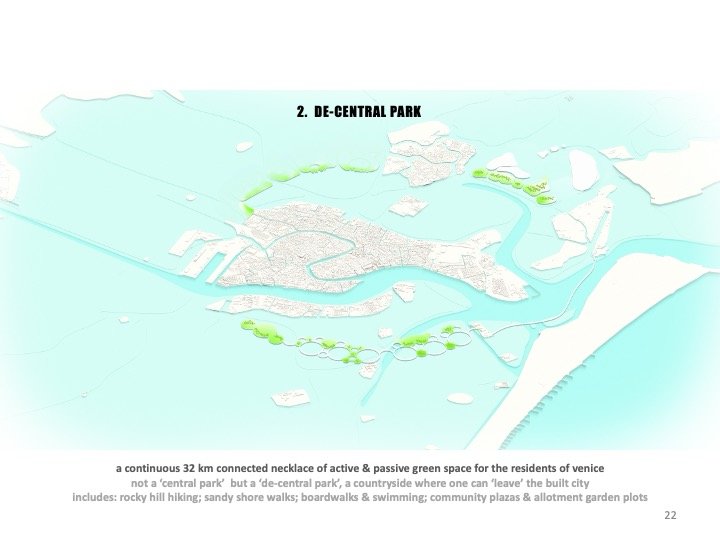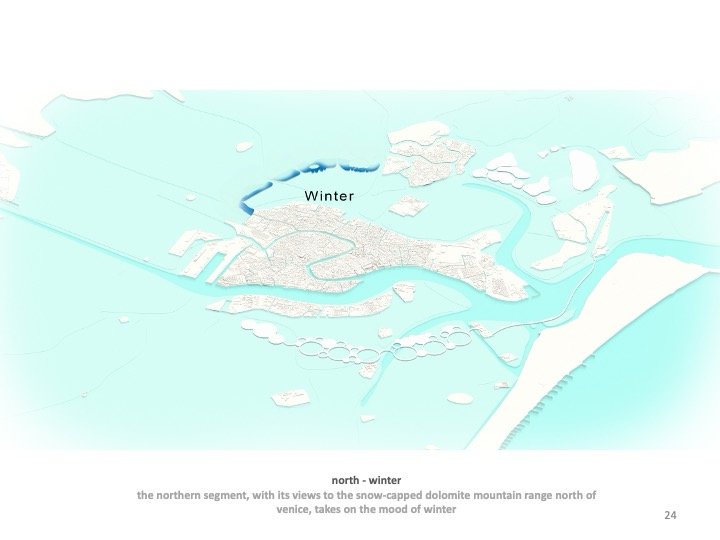
Venice Archipelago Project
Location: Venice, Italy
Category: Place-Making
Scope: Master Planning
Collaborators: Davide Ruzzon, Claire Daugeard, and Carolin Vogelei
Architect: Farrow Partners
The Venice Archipelago Project is a practical and previously unimagined way for Venice to address the “twin floods” of rising sea levels and mass tourism which have inundated the city to devastating effect for the last 50 years. The research and planning of the project grew out of collaborative work at IUAV University of Venice.
Venice faces potentially devastating dangers from climate change. Rising sea levels and ever more frequent flooding have rendered the ground floors of a third of all buildings uninhabitable. As with water, Venice is equally flooded by tourists. More than 20 million tourists visit every year, and as many as 110,000 tourists visiting per day in peak season. The Venice Archipelago Project proposes a new way forward, using saluto-systemic human and health-centered strategies for designing complex urban systems, Farrow Partners has developed and continues to evolve the plan since its conception at IUAV.
The Venice archipelago Project consists of four primary elements:
A Flood and Cruise Ship Barrier: The interlinked necklace of new and existing islands will form a legible, circular, string-like flood and storm surge barrier, purposely designed to be low in profile and hug the waterline to preserve iconic views. The new islands will be of different shapes and uses, separated by watercourse locks spanned by pedestrian bridges. This will allow small to medium sized boats between and around existing islands while creating a barrier against cruise ships. The cruise ships have caused considerable damage to the lagoon, historic islands, and buildings of Venice through pollution and erosion caused by their powerful wakes.
De-Central Park: A 20-mile mixed-use park system of active and passive green space will surround Venice, behaving as a de-central park. Similar to the countryside, residents of the city can go to experience nature, leaving the city behind. The park will offer a range of recreational and social amenities including walking and bike paths, running routes, skating rinks, playgrounds, dog runs, outdoor fitness areas and more. The de-central park will also focus on food production through community allotment gardens, micro farms, and flower markets.
Active Precision Agriculture and Aquaculture Pavilions: In addition to community allotment gardening, the Venice Archipelago Project will offer a range of sustainable commercial activities located in agri-pavilions throughout the park. These activities will build on the long history of local agriculture in the Venetian lagoon and while also creating job opportunities. The agri-pavilions will include hydroponic seed production using carefully controlled lighting conditions to optimize photosynthesis.
Four Seasonal Zones: The archipelago is divided into four segments oriented to the four cardinal directions of North, East, South, and West. Each zone has its own mood, related to its location, and is overlaid with a seasonal Stimmung of winter, spring, summer, or fall. This reminds residents of the constant cycle of nature and is also a nod to Venice’s most famous son, Antonio Vivaldi, composer of The Four Seasons.
To learn more about the Venice Archipelago Project read the full project report, here.























